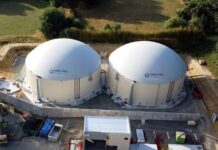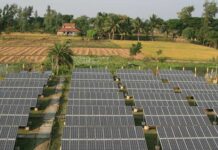The semiconductor manufacturing process is highly energy-intensive, making sustainability a significant concern as demand for these critical components increases. Transitioning to renewable energy sources for semiconductor fabrication or wafer fabrication not only reduces environmental impact but also enhances energy security and operational efficiency. According to Consegic Business Intelligence, Wafer Fabrication Market size is estimated to reach over USD 105.98 Billion by 2031 from a value of USD 67.81 Billion in 2022 and is projected to grow by USD 69.86 Billion in 2023, growing at a CAGR of 5.3% from 2023 to 2031.
Energy Consumption in Semiconductor Manufacturing
- Cleanroom Operations: Cleanrooms, essential for preventing contamination, consume vast amounts of electricity to maintain stringent temperature and humidity levels. These environments require continuous operation of HVAC systems and HEPA filters, ensuring the necessary precision and cleanliness for chip production.
- Process Equipment: The equipment used in wafer fabrication, including chemical vapor deposition (CVD) and etching tools, operates at high temperatures and requires significant energy. Each step in the manufacturing process demands precise control, adding to the overall energy consumption.
- Water Purification and Waste Treatment: Semiconductor manufacturing depends on ultra-pure water (UPW). The processes to produce and recycle UPW involve extensive filtration and deionization stages, which are energy-intensive. Managing wastewater generated during fabrication also adds to the energy burden.
Renewable Energy Sources for Semiconductor Manufacturing
- Solar Power – Solar energy offers a scalable solution for reducing reliance on traditional power sources. Semiconductor manufacturers can utilize on-site solar installations or large solar farms to generate electricity. Companies like Intel have implemented solar projects at multiple facilities, significantly offsetting their energy use from non-renewable sources.
- Wind Energy – Wind energy is another viable renewable resource, particularly in regions with steady wind patterns. Samsung and other major players have invested in wind power to supplement their energy needs. Wind turbines can be installed both on-site and off-site, providing a flexible and sustainable energy supply.
- Hydroelectric Power – Hydroelectric power is a stable and reliable renewable energy source, especially beneficial for fabs located near water bodies. TSMC utilizes hydroelectric power to meet part of its energy demands, demonstrating the practicality of this renewable source even in energy-intensive industries.
Case Studies
- Intel’s Solar Initiatives – Intel has pioneered the integration of solar energy into semiconductor manufacturing. With significant solar installations at facilities in Arizona, New Mexico, and Oregon, Intel generates substantial renewable energy, reducing its carbon footprint and reliance on fossil fuels. For example, the Chandler campus in Arizona features a 7.7 MW solar installation.
- TSMC’s Renewable Energy Integration – Taiwan Semiconductor Manufacturing Company (TSMC) has committed to using renewable energy by purchasing renewable energy certificates and investing in solar and wind projects. TSMC aims to meet 25% of its energy needs from renewable sources by 2030, reflecting its commitment to sustainability.
Benefits of Renewable Energy in Semiconductor Manufacturing
- Environmental Impact – Transitioning to renewable energy significantly reduces the carbon emissions of semiconductor manufacturing. By using solar, wind, and hydroelectric power, companies can lower their greenhouse gas emissions, contributing to global climate change mitigation efforts.
- Energy Security and Cost Stability – Renewable energy sources offer greater energy security and cost stability. Solar and wind energy, in particular, provide predictable operational costs, unlike the volatile prices of fossil fuels. This stability helps semiconductor manufacturers manage long-term energy expenses more effectively.
- Corporate Social Responsibility – Adopting renewable energy enhances a company’s corporate social responsibility (CSR) profile. It demonstrates a commitment to environmental stewardship, improving brand reputation, and attracting environmentally conscious customers. Companies like Analog Devices and Lam Research are noted for their sustainable practices, setting industry standards.
Challenges and Future Prospects
- Initial Investment – The upfront costs for renewable energy infrastructure can be high. However, the long-term benefits, including reduced operational costs and improved energy independence, often justify the investment. Government incentives and subsidies can further offset these initial expenses, making the transition more feasible.
- Technological Integration – Integrating renewable energy into existing manufacturing processes requires sophisticated planning and adjustments. Advanced energy management systems and smart grids can facilitate this integration, ensuring a smooth transition by optimizing energy use and providing real-time monitoring and control.
Conclusion
The semiconductor industry is advancing towards sustainability by incorporating renewable energy sources such as solar, wind, and hydroelectric power. This transition not only reduces environmental impact but also enhances energy security and operational efficiency. By investing in renewable energy, semiconductor manufacturers are paving the way for sustainable industrial practices across other high-energy-demand sectors. The shift towards renewable energy is a strategic move that benefits the environment, strengthens energy security, and enhances corporate social responsibility, positioning the semiconductor industry as a leader in sustainability.







![SMART ENERGY WEEK [September] 2025 to Lead Global Renewable Energy Advancements SMART ENERGY WEEK](https://timestech.in/wp-content/uploads/2025/07/Untitled-design-2025-07-31T112230.406-218x150.jpg)









